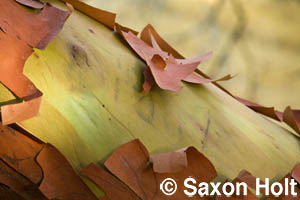Summer has now slipped into September, and the Madrone bark cracks.
Like sinews along the branch, the bark peels back revealing a fresh new skin, vaguely green and ready for winter growth. The old skin exfoliates almost suddenly, brought on by heat in a seasonal pattern nature repeats every summer. A sure sign that, here in California, autumn is nigh.
I am blessed to have Madrones, Arbutus menziesii, in my garden, the finest of all California trees for gardeners. I do love Oaks and have many on my property, but they get huge and too large for most gardens. The madrone is near perfect: fragrant spring flowers, big glossy evergreen leaves, red bark shedding every fall, and red winter berries the birds adore.
On young trees the bark peels back completely but as the tree ages a tougher, true bark forms. But even the older, gray bark has a shaggy appearance, and it too is subject to eruptions of new skin forcing its way to the sun. I have come to appreciate this process as a sign, a sure and fleeting sign like cherry blossoms in the spring, that the seasons are changing. Somehow I find great comfort knowing nature carries on despite our fears, and seeing the madrone’s peeling reminds me nature does carry on.
I take these trees for granted knowing they are native to my hillside and I have soil with just the right mycorrhizal fungi to grow them effortlessly in the garden. They all grow slowly but the wild ones on the hill seem to grow imperceptibly. Yet nature’s slow steady progress is marked in one gnarly tree by the names carved into the bark by my children’s friends.
I can no longer quite read which friend this was and it is not important. The tree is doing its best to forget and in another year the scar will heal and peel away. Yet this process too reminds me of a pattern in life: children grow up and move on. Nature carries on.
As a photographer, I now get to the point of all this pattern talk. The camera gives us a tool to explore, find patterns and give meaning to what we see. It is not that the camera lies, it reveals – and hopefully communicates.
I confess I boosted the orange color and enhanced the yellow to give it a greener cast. (I did not work in the red and green color channels for those who want a color tutorial) The curling bark looked like paint peeling off an old wall somewhere and seemed a proper subject for a photograph. Can I share one more ?
What patterns are you fellow bloggers finding that show the season’s change ?





